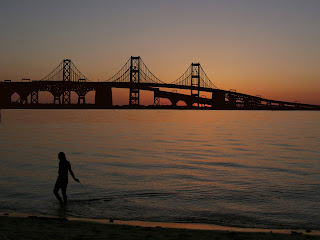Monday, October 19, 2009
Art Education Philosophy
Monday, October 12, 2009
Sense of Place

 While looking over last years projects I saw plenty that were wonderful. I noticed alot of people commented on Sarah's Shaping Meaning Lightbox and I must say I thought it was fantastic. I could watch that video over and over of how the shapes come out when the light is added. I love learning something new, and this gave me new ideas to carry into a classroom. I could imagine how a class of of 3rd graders would erupt when they saw their images light up.
While looking over last years projects I saw plenty that were wonderful. I noticed alot of people commented on Sarah's Shaping Meaning Lightbox and I must say I thought it was fantastic. I could watch that video over and over of how the shapes come out when the light is added. I love learning something new, and this gave me new ideas to carry into a classroom. I could imagine how a class of of 3rd graders would erupt when they saw their images light up.In this image I used collage of photographs. I see an image in my mind that I cannot find in real life. From this idea I find different parts of images and manipulate them to create what I want; an image that means something to me from two or more that ultimately mean nothing. Here, I have exactoed (real word?) the Chesapeake Bay Bridge, blacked it out, and placed it to create a perfect horizon and back drop to some random girl walking in thought on the shore. Neither picture really does it for me, but together they fulfill my desire for a fantasy location that does not really exist. In the second image, I have shown a different picture with this same philosophy. I took a picture of the Cologne Cathedral, but I did not like it's location. So I put it in a field. I did not like the dull sky, so I gave it one that most closely fit my desired location.

Saturday, October 10, 2009
Silhouette Lesson Plan
Grade Level: Middle School
Title: Shaping Meaning Silhouette
Brief History and Background:
A silhouette is a view of an object or scene consisting of the outline and a featureless interior, with the silhouetted object usually being black. The term was initially applied in the 18th century to portraits or other pictorial representations cut from thin black card.
The term has been extended to describe the sight or image of a person, object or scene that is backlit, and appears dark against a lighter background. Because a silhouette emphasises the outline, the word has also been used in the fields of fashion and fitness to describe the shape of a person's body or the shape created by wearing clothing of a particular style or period.
Silhouette images may be created in any artistic media, but the tradition of cutting portraits from black card has continued into the 21st century.
The word silhouette is an eponym of Etienne de Silhouette, a French finance minister who in 1759 was forced by France's severe credit crisis during the Seven Years War to impose severe economic demands upon the French people, particularly the wealthy.[1] Because de Silhouette enjoyed making cut paper portraits, his name became synonymous with these portraits and with anything done or made cheaply. Prior to the advent of photography, silhouette profiles cut from black card were the cheapest way of recording a person's appearance.
Kara Walker's silhouette images work to bridge unfinished folklore in the South, raising identity and gender issues for African American women in particular. However, because of her confrontational approach to the topic, Walker's artwork is reminiscent of Andy Warhol's during the 1960s. Warhol had a strong influence on Walker's work. Her nightmarish yet fantastical images incorporate a cinematic feel. Walker uses images from historical textbooks to show how African American slaves were depicted during Antebellum South.
Standards:
9.1.8.A – Know and use the elements and principles of each art form to create works in the arts and humanities. Visual Arts: Color Form Shape Line Space Texture Value
9.1.8.F – Explain works of others within each art form through performance or exhibition.
9.3.8.B – Compare and contrast informed individual opinions about the meaning of works in the arts to others.
Goal: To create a silhouette.
Objectives:
- Students will understand the meaning and uses of silhouettes in past and present art.
- Students will demonstrate ability to create a silhouette through collage.
- Students will affectively display their knowledge of critique and vocabulary through assessment.
Resource Materials/Visual Aides: Silhouette images. Look for images from Karl Johnson, Lena Karpinksy, and especially Kara Walker for her use of silhouette imagery to illustrate black history. Walker is known to be the youngest winner of the Macarthur Genius Grant for her controversial cutout silhouettes.
Kara Walker:
http://tang.skidmore.edu/documents/images/h-n/kara_walker_002_lg.jpg
Karl Johnson:
http://www.cutarts.com/catalog.php?item=47&catid=3&ret=catalog.php%3Fcategory%3D3
Lena Karpinsky:
http://media.photobucket.com/image/lena%20karpinsky%20silhouettes/decorative-artworks/lena-karpinsky/207/20761_1.jpg
Supplies/Materials: Photographs (Students’ or Teachers’), Magazines, Sharpie Markers/Black Paint, Scissors, Glue.
Teacher Preparation: Have an exemplar made of a silhouette on a landscape. Have students bring in photographs if they like.
Teaching
Introduction: Ask students if they know what silhouette means. Can they name things in modern society that use silhouettes? Who has made a silhouette? Can anyone name any famous silhouettes? Show Mickey Mouse.
Directions:
- Find images to use as your silhouette and background in photographs and magazines. Remember that the subjects will be blacked out, and stand out more when the background is bright.
- Use scissors to cut out the subjects.
- Trace these images on white paper to create a visual maquette.
- Plan your final image.
- Use the sharpie or paint to completely black out the subject cutouts.
- Paste the subjects on your background to create the silhouette.
Critique/Evaluation/Assessment:
Put up the students work. Have them comment on themes and ideas that they see. What do they like and why? What could be improved upon?
Time Budget: 45 Min Classes
Class 1: Introduction - 12 Minutes
Distribution - 3 Minutes
Working Time - 20 Minutes
Cleanup - 10 Minutes
Class 2: Maqette examples - 5 Minutes
Distribution - 3 Minutes
Working Time - 30 Minutes
Cleanup - 8 Minutes
Class 3: Assessment
Vocabulary:
Silhouette - the outline of a body viewed as circumscribing a mass.
Collage - an artistic composition made of various materials (as paper, cloth, or wood) glued on a surface.
Positive Space – The part of the picture plane that occupies the subject.
Negative Space - The part of the picture plane that does not occupy the subject.
Civil Rights - Rights to personal liberty established by the 13th and 14th Amendments to the U.S. Constitution and certain Congressional acts, esp. as applied to an individual or a minority group.
Prejudice - Unreasonable feelings, opinions, or attitudes, esp. of a hostile nature, regarding a racial, religious, or national group.
Discrimination - Treatment or consideration of, or making a distinction in favor of or against, a person or thing based on the group, class, or category to which that person or thing belongs rather than on individual merit: racial and religious intolerance and discrimination.
Safety Concerns: Scissors are sharp.
Bibliography/References:
“Homage to Edward Gorey, the Dark and Light Side of Silhouettes”. The Well Educated
Pony. http://educatedpony.wordpress.com/2009/09/17/homage-to-edward-gorey-the-dark-and-light-side-of-silhouettes/
"Art By Lena." Ed. Lena's Fine Art. Web.
http://www.artbylena.com/original-painting/20458/rain-silhouettes.html
"Cut Arts." Ed. Julie Tomlin. Web.
http://www.cutarts.com/
“Timeline results for silhouette images”.
http://www.google.com/#q=silhouette+images+history&hl=en&safe=off&sa=X&tbo=p&tbs=tl:1,tll:1759,tlh:1759&ei=w7DcSp_zN82llAfmz7ihAQ&oi=toolbelt_timeline_result&resnum=1&ct=timeline-date&ved=0CCIQzQEwAA&fp=a69ab4f64e682ea3
Thursday, October 8, 2009
eLecture
11/01/09
eLecture on Styrofoam Relief Printing for grades 5 and up
Styrofoam Relief Prints are based on woodcut printing. Both are types of relief printing. Relief prints are the first types of printing and the only type traditionally used in the far east. It is believe that it was originally created to print patterns on fabric (fiber art-still practiced today). Artifacts from Mesopotamia dating back to 3,000 BC show evidence of clay stamps made for this purpose. Relief prints were used in China to create the first books, believed to be Buddhist text.
Some examples of well known artists and artwork include Hokusai. He was a Japanese woodcut artist who produced one of the most famous Japanese prints, The Great Wave Off Kanagwa.

Hokusai – The Great Wave Off Kanagwa
Henri Matisse and Pablo Picasso were two of the most influential artists in the twentieth century. Their stylistic innovations altered the course of modern art and managed to affect generations of following artists. Both used relief printing as one of their methods. Relief prints are a natural medium for Cubist artists due to it’s ability to achieve flat shapes. Form and volume is still possible, however it is a greater challenge for the artist.

Henri Matisse – Florentine

Pablo Picasso - Tête de Femme
Though there are numerous methods to create a relief print. The most effective way to cover this technique in the classroom is with Styrofoam. Follow the simple instructions below to demonstrate and teach artists this wonderful technique.
Questions to ask yourself before you begin.
What are some different forms of relief?
What different civilizations used relief in art?
How can using multiple plates and colors affect the outcome of the image?
How can relief prints be used to convey a geometric feel to an image?
Follow these links to view the simple instructional video on how to create your own Relief Print –
Part 1 http://www.youtube.com/watch?v=SzZNU-3glds
Part 2 http://www.youtube.com/watch?v=ECZ7HJotoVI
Things you will need to begin-
Ink
Paper
Brayer – The roller used for applying ink. The term “Ink up” means to apply ink to the relief with the Brayer.
Baren – Soft tool with a handle used to rub the ink from the relief onto the paper.
Ball Point Pen
Styrofoam Relief Sheet/ Styrofoam Plate
Rolling Plate
To begin we will start by brainstorming a sketch approximately the same size as the print you will make. After you have completed your sketch, trace it lightly onto your Styrofoam plate. Once your image is sketched, use the ballpoint pen and trace your lines pressing into the foam as you do. After you are satisfied with your relief marks, we need to ink the Rolling Plate. Squeeze three two-inch lines onto your Rolling Plate. Now use the Brayer to roll out the ink in an even layer. It is useful to switch between perpendicular directions to spread the ink effectively. When the ink is evenly spread, use the brayer to ink up your relief. You’ll want to make sure the entire relief is adequately covered, but you don’t want to fill all the impressions with ink. This will result in the loss of line. Take your inked relief and flip it over onto your paper. Use the Baren to provide even pressure and transfer the ink to the paper. Use a circular motion when using the Baren. Once you think you’ve transferred the ink, peel off your relief to reveal your relief print!
The Styrofoam plate can be reused several times. Just wash it off in the sink with warm water. This fun project is suitable for children 10 and up, though supervision with younger children can allow even younger artists to enjoy relief printing.
Resources:
Boisseree - http://www.boisseree.com/en/originalprint/originalprint.html
Lino-Cut Printmaking - http://teachers.henrico.k12.va.us/godwin/hoen_l/artinsight1/art1projects/PrintingLinoCut.html
ColourLovers - http://www.colourlovers.com/blog/2007/09/20/the-colors-of-woodblock-painting
Thursday, October 1, 2009
WebQuest
http://questgarden.com/93/41/9/091209185528/
